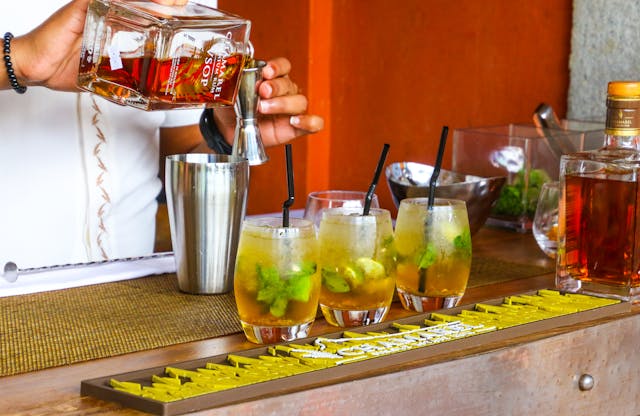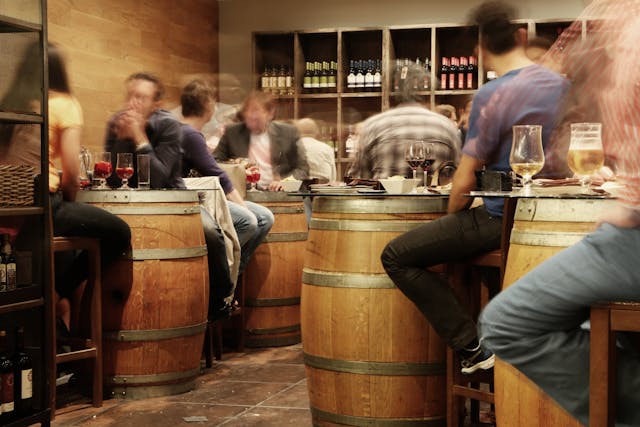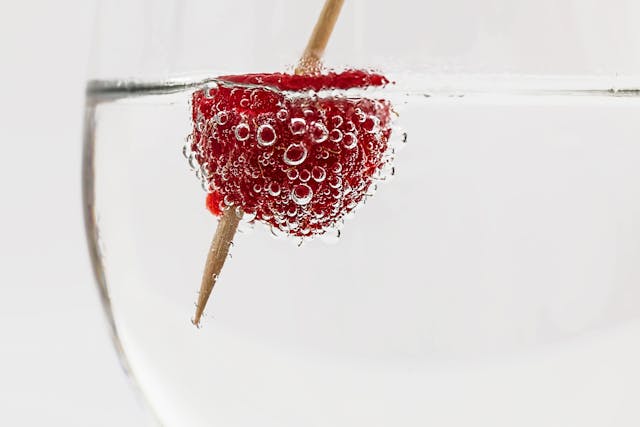Controlling your alcohol consumption intake is vital for the long-term health of your body. For this, we analyse the percentage of alcohol and calories in each type of drink. We also explore the effect of alcohol on our health as well as recommend you the alcohol drink with least calories.
Table of Content:
- Alcohol Consumption Control
Alcohol Consumption Control
In general, alcohol always associates with negative health impact. But if you choose to drink alcohol, it’s important to familiarize yourself with the amount of alcohol and calories in each alcoholic drink. Alcoholic beverages come in a wide range of varieties, each with its own distinct alcohol content and calorie count. The percentage of alcohol by volume (ABV) directly impacts the caloric content of a drink, as alcohol itself contains approximately 7 calories per gram. Beverages with higher ABV, such as spirits, often carry more calories compared to lighter drinks like beer or wine.
What is ABV in Alcohol?
ABV (Alcohol by Volume) is a standard measure used to quantify the amount of alcohol (ethanol) present in an alcoholic beverage. It represents the percentage of the liquid’s total volume that is pure alcohol. For example, if a beverage has an ABV of 10%, it means that 10% of the liquid is alcohol, while the remaining 90% consists of water and other ingredients. ABV is a crucial metric for understanding the strength of a beverage and helps individuals make informed choices about alcohol consumption.
Higher ABV = More Alcohol: Beverages with a higher ABV, such as spirits, contain more alcohol than those with a lower ABV, like beer or wine.
Health Considerations: Drinks with higher ABV will have stronger intoxicating effects and may carry more calories, as alcohol is calorie-dense (about 7 calories per gram).
The following is an overview of the different types of alcohol.

Beer ABV & Calories
Beer is one of the most common alcoholic beverages and comes in different varieties, including light and regular beer. Light beer typically has an ABV of 3-4% and contains around 90-120 calories per 12-ounce serving. Regular beer, with an ABV of 4-6%, tends to have more calories, ranging from 150 to 200 per serving.
Wine ABV & Calories
Wine, whether red or white, contains more alcohol than beer but generally fewer calories per serving. Red wine typically has an ABV of 12-15%, with 125-150 calories in a 5-ounce serving. White wine is slightly lower in alcohol, with an ABV of 11-14% and around 120-130 calories per serving. Champagne and sparkling wines offer a similar ABV, but with a slightly lower calorie count, typically between 90-120 per glass.
Spirits ABV & Calories
Hard liquors like whiskey, vodka, gin, tequila, and rum have much higher ABV, generally around 40-50%. These spirits contain approximately 96-120 calories in a 1.5-ounce shot. Some distilled spirits, such as absinthe or brandy, can have an ABV as high as 60%, which also increases their caloric content.
Liqueurs and Specialty Drinks ABV & Calories
Liqueurs like Baileys and Kahlua, with added sugars and flavorings, often have lower alcohol content, ranging from 15-30%, but they are high in calories, usually containing 150-200 calories per serving.
In summary, the alcohol content and calorie count vary significantly across different types of drinks, with higher ABV beverages typically containing more calories.

What’s the percentage (ABV%) alcohol in each type
- Beer (Light)
ABV: 3-4% - Beer (Regular)
ABV: 4-6% - Wine (Red)
ABV: 12-15% - Wine (White)
ABV: 11-14% - Champagne/Sparkling Wine
ABV: 11-12% - Cider (Hard)
ABV: 4-6% - Whiskey
ABV: 40-50% - Vodka
ABV: 40-50% - Gin
ABV: 40-50% - Tequila
ABV: 40-50% - Rum
ABV: 40-50% - Brandy
ABV: 35-60% - Liqueur (e.g., Baileys, Kahlua)
ABV: 15-30% - Port Wine
ABV: 18-20% - Absinthe
ABV: 45-74%

How many calories in each alcohol drink?
- Beer (Light)
Calories (12 oz/355 mL): 90-120 calories - Beer (Regular)
Calories (12 oz/355 mL): 150-200 calories - Wine (Red)
Calories (5 oz/150 mL): 125-150 calories - Wine (White)
Calories (5 oz/150 mL): 120-130 calories - Champagne/Sparkling Wine
Calories (5 oz/150 mL): 90-120 calories - Cider (Hard)
Calories (12 oz/355 mL): 160-200 calories - Whiskey
Calories (1.5 oz/44 mL): 100-120 calories - Vodka
Calories (1.5 oz/44 mL): 96-110 calories - Gin
Calories (1.5 oz/44 mL): 96-110 calories - Tequila
Calories (1.5 oz/44 mL): 96-110 calories - Rum
Calories (1.5 oz/44 mL): 96-110 calories - Brandy
Calories (1.5 oz/44 mL): 100-120 calories - Liqueur (e.g., Baileys, Kahlua)
Calories (1.5 oz/44 mL): 150-200 calories - Port Wine
Calories (3.5 oz/105 mL): 165-185 calories - Absinthe
Calories (1.5 oz/44 mL): 110-140 calories

Alcohol Impact on Health
Controlling alcohol intake is essential for maintaining both physical and mental health, as well as for fostering overall well-being. While moderate alcohol consumption may have some social or even limited health benefits, excessive or uncontrolled intake can lead to a range of serious health risks, emotional challenges, and social problems. Understanding these risks and making mindful choices about alcohol is crucial for living a balanced, healthy life.
Physical Health
Excessive alcohol consumption is linked to numerous health problems, including liver diseases such as cirrhosis, cardiovascular issues, high blood pressure, and an increased risk of several cancers, particularly in the liver, breast, and digestive system. It also affects the immune system, making the body more susceptible to infections. Even occasional binge drinking can put a strain on the heart, liver, and digestive organs, leading to long-term damage if not controlled.
Mental and Emotional Health
Alcohol can severely impact mental health. While it may temporarily ease stress or anxiety, over time, it can increase symptoms of depression, anxiety, and other mental health disorders. Chronic alcohol abuse can also lead to alcohol dependence, which may disrupt personal and professional relationships, erode self-esteem, and impair decision-making and cognitive function.
Social and Behavioral Effects
Uncontrolled alcohol use often leads to poor judgment, risk-taking behaviors, and strained relationships. It can cause accidents, particularly drunk driving, which endangers not only the drinker but also others. Socially, excessive alcohol consumption can alienate friends and family and lead to legal and financial troubles.
Long-term Benefits of Moderation
By controlling alcohol intake, individuals can improve their long-term health outcomes, maintain healthier relationships, and enhance emotional stability. Moderate or low alcohol consumption supports better sleep, improved cognitive function, and higher energy levels. In the long run, mindful drinking or complete abstinence can contribute to a more fulfilling and productive life.

Alcohol With Least Calories
If you’re looking for alcoholic beverages with the least calories, the ones that generally have the lowest calorie counts tend to have lower alcohol content and fewer added sugars or mixers.
Things to remember.
- ABV (Alcohol by Volume) indicates the percentage of alcohol in the beverage.
- Calories are estimated based on typical serving sizes for each type of alcohol.
- Higher ABV beverages tend to have more calories due to the higher alcohol content.
- Some liqueurs and cocktails may have added sugars, increasing their calorie content.
The most low-calory recommended drink is Vodka or Tequila (or other clear spirits) with soda water. Vodka, gin, or tequila mixed with soda water (zero calories) is one of the lowest-calorie options. Add a lime wedge for flavor without extra calories.
For beer, choose light beer. Light beers contain fewer calories and less alcohol than regular beers, making them a lower-calorie choice for casual drinking.
When choosing champagne or sparkling wine, go for the dry one. Dry varieties of champagne or sparkling wine have fewer sugars and lower calorie counts compared to sweet or dessert wines.
For wines, choose dry wines as well. Dry white wines (e.g. Sauvignon Blanc) have less sugar and fewer calories than sweeter wines. Dry red wines, like Pinot Noir, tend to be lower in calories compared to sweet or fortified wines.
Keep in mind that too keep calorie counts low, it’s important to avoid sugary mixers like soda, juice, or syrups. Instead, opt for soda water or use natural flavorings like citrus.
Health Organizations Recommendations
The following are alcohol consumption guidelines from 3 main health organizations around the world (USA, UK, and Australia).
The National Institute on Alcohol Abuse and Alcoholism (USA) recommends drinking in moderation. This means limiting consumption for men of 2 drinks or less per day and for women 1 drink or less per day.
The National Health Service NHS (UK) provides alcohol intake guidelines. It recommends 14 units or less of alcohol per week (spread across 3 days or more). This refers to around 6 medium glasses of wine of 175ml, or 6 pints of beer of 4% ABV.
The Department of Health and Aged Care (Australia) recommends the alcohol consumption intake of no more than 10 standard drinks in one week and no more than 4 standard drinks on any one day.


